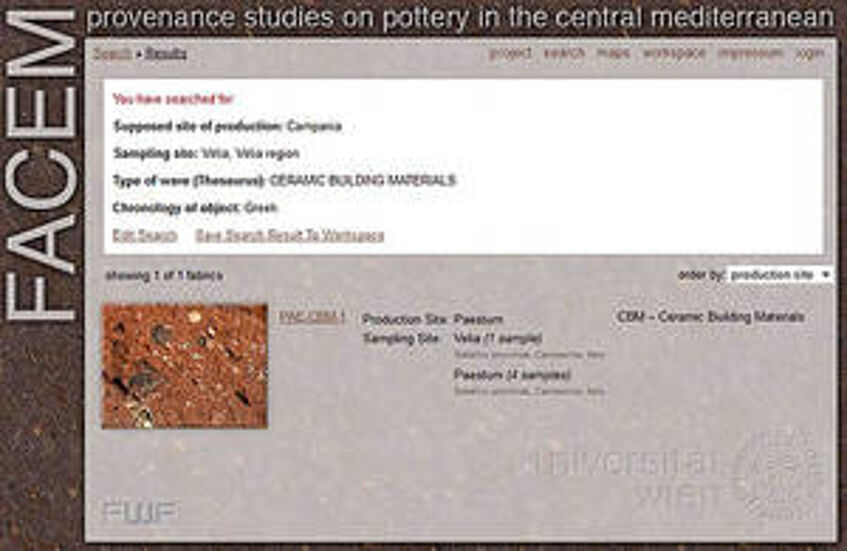Director of the project: a.o. Prof. Dr. Verena Gassner
Collaborators: Dr. Babette Bechtold, Dr. Maria Trapichler, Mag. Silvia Radbauer, Mag. Kurt Schaller (†) Cultural Heritage Computing (CHC), University Salzburg
In cooperation with: Prof. Giovanna Greco, Dipartimento delle discipline storiche “Ettore Lepore”, Università degli Studi di Napoli Federico II Prof. Roald Docter, Department of Archaeology and Ancient History of Europe, Greek Archaeology - Phoenician and Punic Archaeology, Ghent University
Financation: Fonds zur Förderung der wissenschaftlichen Forschung (P 20597-G02, 1 july 2008 – 31 december 2010)
Facem (= Fabrics of the Central Mediterranean, www.facem.at) is a database for specialists of Greek, Punic and Roman pottery, organized by the Institute of Classical Archaeology of Vienna and the CHC Salzburg in collaboration with the Dipartimento delle discipline storiche “Ettore Lepore”, Università degli Studi di Napoli Federico II, the Department of Archaeology and Ancient History of Europe, Greek Archaeology - Phoenician and Punic Archaeology, Gent University and many Soprintendenze of Southern Italy, Sicily and Sardinia. Its aim is to give an overview of production centres in the Central Mediterranean region by presenting images and descriptions of fabrics.
The identification of the provenance of ancient pottery is one of the most important topics of current pottery research as the place of origin of a certain object can be used as an indicator for cultural contacts, economic exchange, or change in political power, to mention only a few. Whereas for some classes the origin of an object can easily be determined by decoration or by potters’ stamps, these possibilities do not exist for undecorated pottery. In recent decades, suitable instruments for addressing this problem have been developed both on theoretical and practical levels, resulting in a classification of pottery according to the fabric. These collections of fabrics however, remain normally restricted to the respective teams of excavations or museums, with each of them creating a system of their own. Exchange of expertise between colleagues or correlation of the various systems until now therefore remained restricted to an informal level depending mostly on personal contacts.
The project Facem intends to create a coherent system of fabrics for the Central Mediterranean based on production sites that have been identified by archaeological arguments and/or archaeometric analyses, comparing samples either with pottery of secured or probable provenance (e.g. decorations that can be attributed to ascertained workshops, potters’ stamps, or wasters of pottery workshops). Also the frequency of a fabric on one site can be an argument that has, however, to be reconsidered carefully. Thus when using the database you should keep in mind that Facem does not or only to a minor degree present results of archaeometric research, but primarily those of an archaeological method of pottery classification, using as distinctive feature the quality of the sherd, the fabric, instead of decorative or morphological criteria. The discussion of the results of this archaeological classification and their comparison with conclusions drawn from archaeometric analyses are therefore to be seen as two different, though equally important approaches.
For the publication of these investigations we have chosen a web-based information system to avoid problems normally connected with the publication of large collections of fabric data in conventional print-form. Whereas a printed book, once it has been published, cannot be changed or added to and potential errors cannot be emended, a web-based publication is intended to grow continually as it hopefully will be enlarged by fabrics and/or production centres defined by colleagues on further sites.
To read more: www.facem.at

